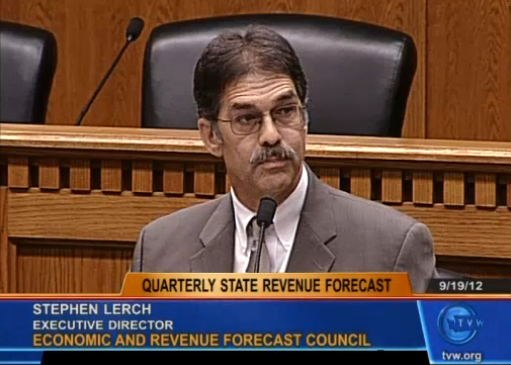Supply chain issues and how the economy will continue to react to the pandemic are issues that Steve Lerch is thinking about. Lerch is the executive director of the Washington State Economic and Revenue Forecast Council, which is tasked with forecasting economic activity and tax revenue. In this interview, we spoke with him about what the data tells him about supply chain shortages, the recovery, and economic trends that began during the pandemic but may continue.

The Morning Wire: Keeping you informed on politics, policies, and personalities of Washington State.
Aaron Kunkler: Based on what you’re seeing, perhaps, what are your thoughts on how the state’s economy is recovering, and how supply chain issues may be impacting it?
Steve Lerch: If we look at state GDP numbers, we have data through the second quarter of this year. If we look at those, the first quarter of 2020 was the previous peak. And that’s when we started seeing businesses shut down and the real impacts of the pandemic. If we look at the state as a whole, it took an entire year, so first quarter of this year, to get back to that level of GDP.
But if we look industry by industry, you see some real variability for when different sectors got back to that first quarter 2020 level. So, for instance, if we were to look at the information sector, we would see that by the third quarter of last year, it was back to that pre-pandemic level of GDP. If we look at the construction sector, it was back to pre-pandemic levels by the fourth quarter of last year. But if you were to look at accommodation and food services, it didn’t really get back to that pre-pandemic level until the second quarter of this year. So it took a full, another quarter to get back. And then if we are to look at the arts, entertainment and recreation sector, that’s going to be theaters, movie theaters, gyms, concert venues, casinos would be in there, it’s still not back to pre-pandemic levels as an entire sector.
AK: What does that tell you about the economic recovery as well as the supply chain?
SL: In some cases — and the arts, entertainment and recreation is a good example — that probably reflects more of a change in consumer behavior. People haven’t wanted to go out and do what some people refer to as socially dense activities. You know, they don’t necessarily want to sit in a crowded movie theater, or go to a concert. So those are probably less likely to be supply chain issues. If we look at the construction sector, which came back faster than the economy as a whole, we know at least there have been some supply chain issues there. Certainly lumber prices ran up very, very high. And they have come back down all the way to pre-pandemic levels. It appears that that was largely mills closing down to address the need for social distancing, and that generated a shortage of lumber at the same time that the construction sector was trying to get back going, there was demand for housing.
We know at least anecdotally, that there was a big demand for a lot of home construction and repair activities, lots of people building decks and things like that. So there was a big demand for lumber. And yet, the supply chain had really caught up, it does appear that that’s the sector where that’s starting to improve.
It’s really hard to tease out with the data we have and know exactly why certain sectors might be taking longer to catch back up. In terms of whether it’s supply chain issues, or difficulty in hiring, we know that certain sectors have had real labor shortages, especially if you were to look at arts, entertainment, recreation sector accommodation, and food services. We know those are sectors where it’s been tough to get back to pre-pandemic staffing levels.
AK: You mentioned consumer preferences might be changing, do you know what that could mean for the economy?
SL: I think that’s one of the things where we saw with a real shift last year as the pandemic set in, a kind of a shift away from all those activities you just mentioned, where you’re going to be around people, and try to do things where you could be socially distance where you could be at home. We saw a big jump in demand for a lot of durable goods that enable people to entertain themselves more at home rather than going out, to set up offices, to set up places for their kids to do school from home. So we saw a big demand for furniture, appliances, electronics, cars, nobody wants to go public transportation.
We’re starting to see some of those things start to slow down a bit. I think it’s a real question as to whether people are going to travel the way they used to. So whether those sectors and the arts, entertainment, recreation, accommodation, and food services, those are going to be sectors that are very sensitive to travel and tourism. Will that come back the way that it has in the past? Or will people want to stay closer to home? I think those are all still questions that we all really have the answers to.
Your support matters.
Public service journalism is important today as ever. If you get something from our coverage, please consider making a donation to support our work. Thanks for reading our stuff.



